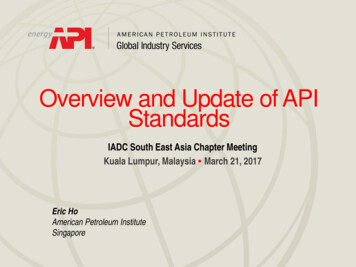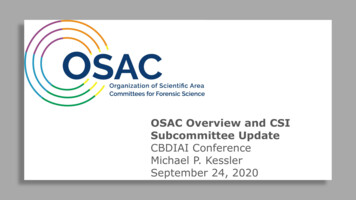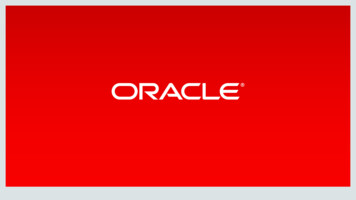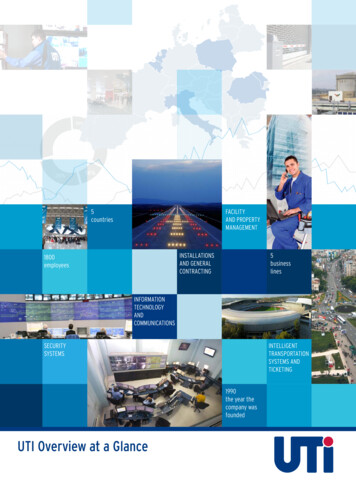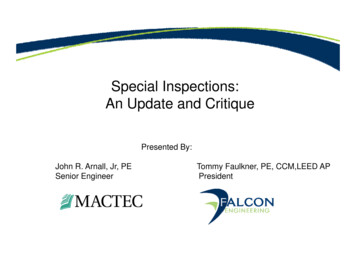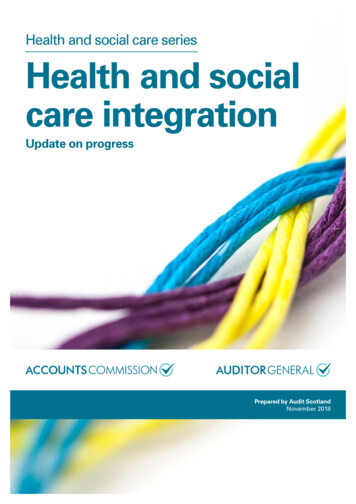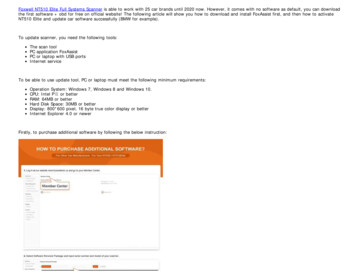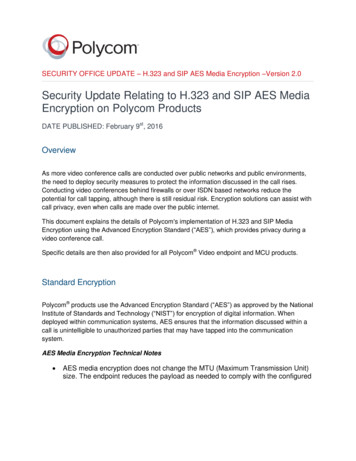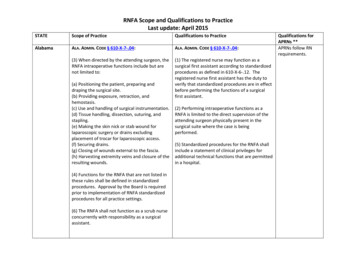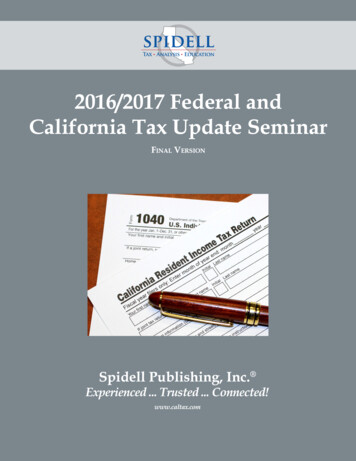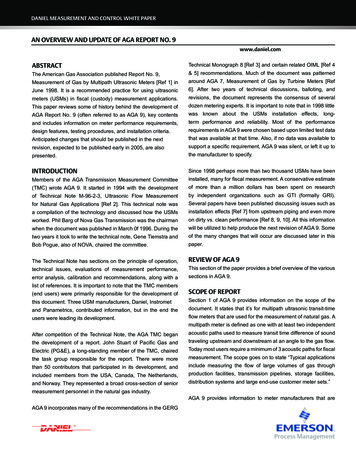
Transcription
AN OVERVIEWANDANDUPDATEOF AGAREPORTDANIELMEASUREMENTCONTROLWHITEPAPER NO. 9page 1AN OVERVIEW AND UPDATE OF AGA REPORT NO. 9www.daniel.comABSTRACTTechnical Monograph 8 [Ref 3] and certain related OIML [Ref 4The American Gas Association published Report No. 9,& 5] recommendations. Much of the document was patternedMeasurement of Gas by Multipath Ultrasonic Meters [Ref 1] inaround AGA 7, Measurement of Gas by Turbine Meters [RefJune 1998. It is a recommended practice for using ultrasonic6]. After two years of technical discussions, balloting, andmeters (USMs) in fiscal (custody) measurement applications.revisions, the document represents the consensus of severalThis paper reviews some of history behind the development ofdozen metering experts. It is important to note that in 1998 littleAGA Report No. 9 (often referred to as AGA 9), key contentswas known about the USMs installation effects, long-and includes information on meter performance requirements,term performance and reliability. Most of the performancedesign features, testing procedures, and installation criteria.requirements in AGA 9 were chosen based upon limited test dataAnticipated changes that should be published in the nextthat was available at that time. Also, if no data was available torevision, expected to be published early in 2005, are alsosupport a specific requirement, AGA 9 was silent, or left it up topresented.the manufacturer to specify.INTRODUCTIONSince 1998 perhaps more than two thousand USMs have beenMembers of the AGA Transmission Measurement Committeeinstalled, many for fiscal measurement. A conservative estimate(TMC) wrote AGA 9. It started in 1994 with the developmentof more than a million dollars has been spent on researchof Technical Note M-96-2-3, Ultrasonic Flow Measurementby independent organizations such as GTI (formally GRI).for Natural Gas Applications [Ref 2]. This technical note wasSeveral papers have been published discussing issues such asa compilation of the technology and discussed how the USMsinstallation effects [Ref 7] from upstream piping and even moreworked. Phil Barg of Nova Gas Transmission was the chairmanon dirty vs. clean performance [Ref 8, 9, 10]. All this informationwhen the document was published in March 0f 1996. During thewill be utilized to help produce the next revision of AGA 9. Sometwo years it took to write the technical note, Gene Tiemstra andof the many changes that will occur are discussed later in thisBob Pogue, also of NOVA, chaired the committee.paper.The Technical Note has sections on the principle of operation,REVIEW OF AGA 9technical issues, evaluations of measurement performance,This section of the paper provides a brief overview of the variouserror analysis, calibration and recommendations, along with asections in AGA 9.list of references. It is important to note that the TMC members(end users) were primarily responsible for the development ofthis document. Three USM manufacturers, Daniel, Instrometand Panametrics, contributed information, but in the end theSCOPE OF REPORTSection 1 of AGA 9 provides information on the scope of thedocument. It states that it’s for multipath ultrasonic transit-timeusers were leading its development.flow meters that are used for the measurement of natural gas. AAfter competition of the Technical Note, the AGA TMC beganacoustic paths used to measure transit time difference of soundthe development of a report. John Stuart of Pacific Gas andElectric (PG&E), a long-standing member of the TMC, chairedthe task group responsible for the report. There were morethan 50 contributors that participated in its development, andincluded members from the USA, Canada, The Netherlands,and Norway. They represented a broad cross-section of seniormeasurement personnel in the natural gas industry.AGA 9 incorporates many of the recommendations in the GERGmultipath meter is defined as one with at least two independenttraveling upstream and downstream at an angle to the gas flow.Today most users require a minimum of 3 acoustic paths for fiscalmeasurement. The scope goes on to state “Typical applicationsinclude measuring the flow of large volumes of gas throughproduction facilities, transmission pipelines, storage facilities,distribution systems and large end-use customer meter sets.”AGA 9 provides information to meter manufacturers that are
DANIEL MEASUREMENT AND CONTROL WHITE PAPERpage 2more performance-based than manufacturing-based. Unlikefor the external conditions a meter is subjected to such as rain,orifice meters that basically are all designed the same, USMdust, sunlight, etc.manufacturers have developed their products somewhatdifferently. Thus, AGA 9 does not tell the manufacturers howThe inside diameter of the ultrasonic meter shall have the sameto build their meter, but rather provides information on theinside diameter as the upstream tube’s diameter and must beperformance the product must meet.within 1%. The value of 1% was based mainly on early EuropeanTERMINOLOGYSection 2 of AGA 9 discusses terminology and definitions thatstudies and also work performed at the Southwest ResearchInstitute’s GRI/MRF (Gas Research Institute/ Metering ResearchFacility) in San Antonio, Texas.are used throughout the document. Terms like auditor, designer,inspector, manufacturer, etc. are defined here.OPERATING CONDITIONSAGA 9 discusses the ability to remove transducers underpressure. With little knowledge about the need to periodicallyremove and inspect, it was thought that removal under pressureSection 3 discusses operating conditions the USM shallwould be a common step of routine maintenance. Thus, thismeet. This includes sub-sections on gas quality, pressures,section also discussed the manufacturer providing some methodtemperatures (both gas and ambient), gas flow considerations,for removal under pressure.and upstream piping and flow profiles. The gas qualityspecifications were based upon typical pipeline quality gas andToday, after several years of experience, most users do notno discussion was included for sour gas applications other thanremove transducers under pressure. History has shown theyto consult with the manufacturer. It is important to note that theseare very reliable. Also, as there are often multiple runs inrequirements were based upon the current manufacturer’sparallel, shutting in a run and depressurizing for transducerspecifications in order to not exclude anyone.removal is often the preferred method. Additionally, once theMETER REQUIREMENTSSection 4 is titled and “Meter Requirements” discusses themany meter conditions manufacturers are required to meet.There are sub-sections on codes and regulations, meter body,ultrasonic transducers, electronics, computer programs, anddocumentation. Section 4 really provides a lot of informationregarding the conditions the meter must meet to be suitable forfield use.The sub-section on codes and regulations states the following:“Unless otherwise specified by the designer, the meter shall besuitable for operation in a facility subject to the U.S. Departmentmeter run is depressurized, the internal condition of the meterand associated piping can be inspected. Some companies evenhave an annual program of internally inspecting their meters.For these reasons extracting transducers under pressure arenot as common as once thought.In 1998 ultrasonic meters were not common pipeline devicesand many operators are unfamiliar with them. AGA 9 includesdirections for the manufacturer in marking their product. Theseinstructions are valuable as they will alert users as to thepertinent information that may affect the performance of themeter.of Transportation’s (DOT) regulations in 49 C.F.R. Part 192,TransducersTransportation of Natural and Other Gas by Pipeline: MinimumThe section on transducers discusses a variety of issuesFederal Safety Standards”[Ref 11].including specifications, rate of pressure change, and transducerMeter BodyThe section on meter body discusses items such as operatingpressure, corrosion resistance, mechanical issues relative to themeter body, and markings. Here is says manufacturers shouldpublish the overall lengths of their ultrasonic meter bodies fortests. The intent was to insure the manufacturer providedsufficient information to the end user in order to insure reliableand accurate operation in the field, and also to insure accurateoperation should one or more pairs need replacement in thefield.the different ANSI flange ratings. It does state that the designerElectronicsmay specify a different length than standard, but in reality thatMuch discussion was given on the issue of electronics and theis rarely done.expected improvements that come with time. The goal of thecommittee was to require electronics that were well tested andCorrosion resistance and compatibility to gases found in today’sdocumented, but allow improvements without placing an unduepipeline is required. Corrosion not only of wetted parts, but alsoburden on the manufacturer. This idea is evident throughout
AN OVERVIEW AND UPDATE OF AGA REPORT NO. 9page 3the document, but is especially relevant in the electronics andpurpose. Thus, each software package does look and operatefirmware sections.differently. To date there have been no requirements onmanufacturer’s to have similar looking and functioning software.The electronics section includes two suggested types ofcommunication to flow computers, serial and frequency. SerialOne of the key features software must do is make it easy forcommunication (digital using either RS-232 or RS-485) isthe technician to understand the meter. Technicians today havesuggested because the ultrasonic meter is clearly a very “smart”a variety of equipment they are responsible for. Thus, one ofinstrument and much of its usefulness relies on the internalthe challenges for the manufacturer is to make software that isinformation contained in the meter. The frequency output iseasy to learn and use. Perhaps in the future there will be certaina convenient option, especially in applications where flowrequirements for interface software, but that is unlikely to be acomputers and Remote Terminal Units (RTUs) do not have therequirement in the next revision of AGA 9.necessary application to poll the USM.Alarms and diagnostic functions are also addressed under theIn reality a majority of users use only the frequency output tocomputer programs heading. These sections were probablyconnect with flow computers. Since each USM manufacturer ofmore difficult to compose because of the differences associatedhas different features, and even different protocols, most flowwith various meter path designs, and the correspondingcomputers at that time (and to some degree even today) did notdifferences in available data. Diagnostic data that is requiredprovide any method for collecting measurement information viamight be categorized into one of three main groups; gas velocity,a serial link. Today more flow computers and RTUs have thegas speed-ofsound and meter health.ability to communicate serially to the various brands of USMs.Thus, the serial link was, and for the most part still is, usedThe velocity data is used to indicate flow profile irregularitiesprimarily for interrogation using the manufacturer’s software.and to calculate volume rate from average velocity. The flowrate is determined from by multiplying velocity times the meter’sAGA 9 requires the manufacturer to also provide digital outputscross-sectional area of the meter. The speed-of-sound data isfor flow direction and data valid. These digital outs are forused as a diagnostic tool to check for erroneous transit timemonitoring by the flow computer to determine direction of flowmeasurement errors. Other information is required to judge the(when a single frequency is used for both forward and reversequality of the data such as percent of accepted ultrasonic pulses,flow). Data valid is an indicator that the meter has an alarmsignal to noise ratio and transducer gains. A discussion on thesecondition that may impact its accuracy.is well documented in several papers [Ref 13 & 14].AGA 9 requires the meter be electrically rated for a hazardousOther meter requirements in this section include anti-rollenvironment as defined by the National Electrical Code [Ref 12].devices (feet), pressure tap design and location on the meter,The minimum rating for a USM is for Class 1, Division 2, Groupand standard meter markings. Many of these requirements areD environments. Some users specify a rating of Division 1, and,based on field experience and the lessons learned from otherfor the most part, all manufacturers design for the more stringentmetering technologies.Division 1 requirement.Performance RequirementsComputer ProgramsOne of the most important sections of AGA 9 is contained inSince ultrasonic meters are electronic, the information containedSection 5, Performance Requirements. This section discussesin the electronics needs to be accessed by the technician. AGAminimum performance requirements the USM must meet.9 requires the manufacturer to store all meter information inIt does not require flow calibration, but rather relies upon thenon-volatile memory to prevent loss of data if power is removed.accuracy of manufacturing and assembly to infer accuracy.It also requires the meter’s configuration be securable so thataccidental changes can be prevented. This is usually done byThis section also defines a variety of terms including three newinserting a jumper or via a switch located on the electronicsflow rate terms. They are Qmax, Qt, and Qmin. Qmax is theinside the enclosure that can then be seal-wired.maximum gas flow rate through the USM as specified by themanufacturer. Qt is the flow rate, as defined by the manufacturer,USMs typically do not provide a local display or keyboardthat’s the lowest before accuracy specifications are relaxedfor communicating with the meter as is traditional with flow(greater error is permitted below this flow ra
on dirty vs. clean performance [Ref 8, 9, 10]. All this information will be utilized to help produce the next revision of AGA 9. Some of the many changes that will occur are discussed later in this paper. REVIEW OF AGA 9 This section of the paper provides a brief overview of the
